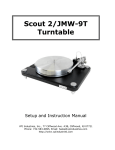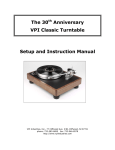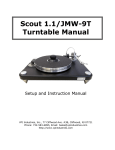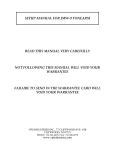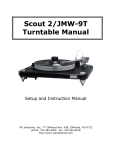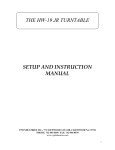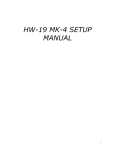Download VPI Classic 1 Instruction manual
Transcript
The VPI Classic 1 Turntable Setup and Instruction Manual VPI Industries, Inc., 77 Cliffwood Ave. #3B, Cliffwood, NJ 07721 phone: 732-583-6895 fax: 732-946-8578 http://www.vpiindustries.com Important: Read Before Proceeding! Read and follow the Safety Instructions below. Save all packing materials. The Classic 1 should only be moved or shipped in its original packaging to reduce the risk of damage in transit. The Classic 1 must be placed on a flat, level surface. This will make setup easy, provide better sound quality, and put less strain on the main bearing. Safety Instructions Follow the instructions below to reduce risk of electrical hazard or injury. 1. To avoid electrical shock, do not open the motor cover. 2. If the power cord provided with the Classic 1 does not reach an outlet, use a heavyduty, grounded extension cord. 3. To avoid electrical shock, always plug the Classic 1 into a grounded outlet. 4. Do not expose the Classic 1 to rain or excessive moisture. 5. Do not touch the male pivot point of the tonearm assembly. It is extremely sharp. Introduction The Classic 1 turntable is a precision instrument. It has been thoroughly tested and run for at least 4 hours. The speed accuracy, wow, flutter, and rumble have been checked, and this unit meets all of our specifications. Minimum Specifications Wow and flutter Less than .02%. Rumble Greater than 80db down. Speed accuracy Within .1%. Total weight 55 pounds. Platter run out +/- .001 inch. Unpacking the Box The turntable and tonearm are packed very carefully to avoid damage during shipping. It is important that you save the packing materials and boxes to use for shipping or moving the Classic 1. Set aside the bag containing the drive belt. 1 Complete and return the warranty card. The warranty does not take effect until the warranty card is returned. Remove and set aside the following items: Alignment Jig. Record clamp. Power cord. Bag containing screwdrivers and screws for mounting the cartridge. Shure Stylus Force Gauge JMW-Classic tonearm wand Remove the large foam top packaging piece and place it on the side. Make room for the turntable, it will be ready to place in its final destination immediately. Grab the turntable on the sides where the foam is cut out and lift straight up. Be careful, the turntable is very heavy (40 pounds) if you need help, get it. Place the turntable on a flat sturdy surface that will support the weight. Lift the aluminum turntable platter from the smaller box, remove the plastic bag, and peel off the tape covering the bearing hole. Be very careful not to hit or damage the motor pulley when sliding the platter on to the spindle shaft. It measured +/- .0005” when it was tested at the factory. Try not to disturb it at all. The platter can be damaged if it is hit, be careful. The paper protection on the platter can be used as a mat if you are not comfortable with the record sitting on the bare aluminum platter. There is also a urethane mat provided for those that must use a mat. We recommend bare platter listening but it is an owner’s choice to decide. SETTING UP THE CLASSIC The Classic 1 must be placed on a flat, level surface. This will make setup easy, provide better sound quality, and put less strain on the main bearing. Place the turntable chassis on the shelf or stand where it will be used. The Classic 1 has very good isolation so it simply requires a good solid shelf on a rack that doesn’t sway in the breeze. You can get very good sound by placing the Classic 1 on a maple butcher block board about 2” thick. The platter bearing is lubricated; no additional lubrication is needed for at least one year. Place the drive belt around the platter and around the pulley on the motor. The belt does not have to be level on the platter. It will self-level when the platter starts rotating. You can powder the belt with baby powder or talc for even better sound. For 33 RPM operation, place the belt on the upper part of the pulley. For 45 RPM operation, place the belt on the lower, wider part of the pulley. The center groove in each diameter is usually the correct speed. 2 Connect the supplied power cord to the Classic 1 in the fused rear socket. Verify the turntable is level by using a 9- or 12-inch bubble level front-to-back and side-to-side on the platter. If it is not level, rotate the TNT mini feet up or down. If you must turn the Classic feet more than three full turns, level the shelf or platform the table sits on first. The power button is on the left side, it is recessed for protection. Turn on the Classic 1 by pushing the power button and allowing 3 seconds for the platter to get up to speed. If you bought the Classic 1 with a Dynavector 20X Special or a VPI/Grado it was installed at the factory and you simply have to drop the arm on the bearing assembly. BEFORE YOU BEGIN Be very careful when handling the tone arm. The internal arm wire is exposed at the headshell and at the rear of the arm. The wire is very delicate and physical damage to the wire is not covered by the warranty after the arm is removed from its box. When you remove the black tube covering the unipivot male bearing assembly be very careful it is sharp, do not touch it, you will get punctured or cut. There are a number of setscrews on the JMW Memorial Tone Arm. The Allen wrenches that come with your arm will only fit the setscrews that you will need to adjust. All other screws are factory set and should not be adjusted, except by our trained technicians. Resetting any of the factory settings is not covered by the warranty. A. CARTRIDGE MOUNTING: FOR CARTRIDGES WITH THREADED MOUNTING HOLES: Use the screws supplied by the cartridge manufacturer to mount the cartridge. Any other screws may not fit the thread properly and may even damage the threads and cartridge. USE ONE OF THE SUPPLIED WASHERS UNDER THE SCREW HEAD. For all cartridges with pass through mounting holes use the hardware supplied with the arm. Remember to use the washers under the screw heads to prevent damage to the finish on the JMW arm. In this step, the connectors will be attached to the cartridge's terminals. Disregard the color of the insulators on the cartridge clips. 3 THE COLOR CODE OF THE WIRE IS: RED = right hot GREEN = right ground BLACK OR WHITE = left hot BLUE = left ground IF YOUR PHONO SECTION INVERTS PHASE, THE HOT COLOR BECOMES THE GROUND COLOR Using tweezers or fine tipped pliers grip the center of the red wire's connector (do not grip the wire) and push it onto the cartridge's right hot terminal pin. In the same way, connect each of the remaining connectors to its respective cartridge terminal. Do not push the connectors all the way on, as this could damage the cartridge. Always back up the cartridge with your finger when pushing on the clips. The 10.5 SE tonearm comes with one large dropped counterweight installed on the rear shaft of the tonearm. For most cartridges you will only need this large weight. The counterweight is held in position by a setscrew. Pick up the arm tube, taking care not to strain or damage the fine 4-color wire and Lemo connector. For now, position the large counterweight as close to the bearing housing as you can (toward the front of the arm) but not touching the balance ring. The object here is to balance the arm while keeping the counterweight as close to the bearing housing as possible. This results in the least inertia for a given cartridge weight. In some rare cases it may be necessary to use two counterweights together or a larger counterweight. Contact your dealer if a second or larger counterweight is needed. B. OVERHANG ADJUSTMENT: This adjustment will yield the lowest distortion in the last third of the record, the hardest to track, when playing a typical 12" record. Do not go crazy over this adjustment. You do not know if the stylus is aligned properly on the cantilever. You are also facing a constantly moving target when playing a record. The arm is moving in 3-dimensions and will only approximate the accuracy you have built into your alignment. Place the arm tube assembly on the lower bearing, taking care not to strain or damage the 4-color wire and Lemo connector. Place the arm in its rest. At the rear of the arm base assembly is the connector block. Plug the Lemo connector into its receptacle on top of the block. Notice that the connector can plug in only one way. Align the red dots on the arms plug with the red dot on the receptacle. Push gently, do not force the plug. Place the Alignment Jig into position by sliding the narrow end with the circular cutout between the arms lateral balance weight and the platform that supports the armrest. Make sure that the jig's cutout fits against and around the bearing well and the hole is over the spindle. 4 While the arm is in its rest, loosen the screws that hold the cartridge just enough that the cartridge can be moved back and forth. Carefully swing the arm over the grid at the far end of the jig and place the stylus as close to the dot in the center of the grid as possible. Using a lighted magnifier will make this job very easy. BE VERY CAREFUL NOT TO DAMAGE THE CARTRIDGE'S STYLUS: Move the cartridge so that the stylus rests on the dot. Now, viewing the cartridge from above, line it up so that its sides are symmetrically positioned between the lines of the grid. If the cartridge has parallel sides, these should be made parallel to the grid lines. Also make sure that the cartridge is centered between the sets of lines. If you can see the cantilever clearly you can align the cantilever to the alignment grid. This is difficult and may produce no increase in sound quality. Double check the adjustments made above. The cartridge needs to be both centered and "square" between the gird lines and have the stylus resting on the dot. Place the arm back in its rest. Without letting the cartridge move, tighten the screws holding the cartridge to the arm head. Make it tight, but don't over do it and strip the threads or distort the cartridge body. 5 FIG #2: THE PROPER WAY TO ALIGN A CARTRIDGE, ALIGN THE CARTRIDGE, NOT THE TONEARM HEADSHELL! SHOWN IN WHITE FOR CARITY. C. TRACKING FORCE AND AZIMUTH Place the arm tube assembly on the lower bearing, taking care not to strain or damage the 4-color wire and Lemo connector. Place the arm in its rest. At the rear of the arm base assembly is the connector block. Plug the Lemo connector into its receptacle on top of the block. Notice that the connector can plug in only one way. Align the red dots on the arms plug with the red dot on the receptacle. Push gently, do not force the plug. Make sure the turntable is level. Refer to your turntable instructions and use a bubble level to check level. In most cases, the best place to put the level is on the platter. With a unipivot arm it is particularly important to level the turntable. Move the counterweight until the arm has a very slight downward tracking force, just enough to keep it from moving sideways on the platter or enough to keep it in the groove of the record Tracking force is adjusted by moving the counterweight forward and back just a bit at a time. At least initially, you will be setting the tracking force twice. The first time will be before the cartridge's overhang is set. After this is done, you will need to double check the tracking force and adjust it as needed. The JMW 10.5i does not have a built-in tracking force gauge, but a Shure Stylus Force Gauge is supplied with your arm on a new unit. Following the gauge instructions set the tracking force to the cartridge manufacturer recommendation plus 1/10 of a gram more. We always recommend going to the high side when it comes to tracking force. High frequency vibrations can cause a light-tracking cartridge to cause more damage 6 to the grooves than running a cartridge at a heavy setting. Make sure the damping fluid is not installed when setting this force. VERY IMPORTANT: MAKE SURE THE TONEARM IS PARALLEL TO THE PLATTER WHEN SETTING THE TRACKING FORCE. IF IT IS NOT THE END RESULT WILL BE HIGHER OR LOWER VTF THAN YOU WANTED. Next, the lateral balance or azimuth must be set. Because the phono cartridge is offset, there is an unbalancing force that tilts the arm to one side. For the cartridge to properly track the record groove, the stylus must be ninety degrees to the record surface. Move the counterweight so a slight tracking force is applied and the stylus just sits on the record surface. use the azimuth ring to set correct azimuth. Lay the long thin rod supplied behind the cartridge mounting screws into the V groove and use it as a guide for setting azimuth. Rotate the flat part of the ring towards the side that is lower and that side will become lighter causing it to rise. Playing with this will give very accurate azimuth settings. Unlike other unipivot arms, the JMW’s lateral balance weight does not hang off to the side of the arm. Instead, its position around the bottom of the upper bearing housing places the weight below the pivot point. This increases mass below the pivot and increases arm stability. In the rear of the counterweight stub there is a large hole, in this hole is a screw that is used for fine adjustment of VTF. Use the large wrench supplied for this operation. Most times you will not need this but it is there if you want to really fine tune. You will need a digital tracking force gauge to use this feature properly. 7 D. ANTI-SKATING: REMEMBER: A 10.5” ARM NEEDS VERY LITTLE ANTI-SKATING FORCE Anti-skating is one of the least understood forces acting on a tonearm. Skating force is created by friction between the stylus and the record, causing a force vector in a direction towards the center of the record when the headshell of the tonearm has an offset angle. Putting a stylus down on a flat, groove less record will cause the arm to move toward the center of the record. Arm manufacturers have tried to compensate for this force, but that is impossible because the force is constantly changing as the music and velocity change. VPI has conducted careful listening tests and determined that every tonearm we tried sounded better with its mechanical anti-skating disabled and the tracking force very slightly increased. VPI has a unique solution to anti-skating: the coiled wire of the JMW Memorial Tonearm acts as a spring and pushes the arm back without affecting the sound quality. You now have the option of using a mechanical anti-skate for those that want it. If you try adjusting the anti-skate with a groove less record, you will ruin the twist in the tonearm wire and void your warranty. Do this with the mechanical anti-skate if you want that much anti-skate. IF ADDITIONAL ANTI-SKATE IS NEEDED FOR WORKING WITH TEST RECORDS YOU CAN GO TO THE MECHANICAL ANTI-SKATE SUPPLIED. E. ARM HEIGHT: Place a record on the turntable. Loosen the two setscrews in the base of the arm (right side and rear of base). Lower the arm onto the record and make the arm tube parallel to the record surface by rotating the wheel with the 4 prongs sticking out. This is a good initial setting. You may wish to vary it depending on the cartridge you are using and or the particular record being played. 8 Remember to always retighten those two setscrews when listening. loose the sound will be unfocused. If they are left H. VISCOUS DAMPING The JMW-Classic has the ability to use damping fluid around the pivot. Use this option sparingly and only if needed with certain cartridge like Grado or Clearaudio or if the sound is not smooth enough. You can now add damping fluid. Use only enough to stabilize the arm, too much will kill the sound and make the cartridge sound slow. Try listening with and without damping and decide which you like better in your system and with your cartridge. Fill only ½ to begin, excess will spill over and make a mess. I. CONNECTING TO THE PREAMPLIFIER/AMPLIFIER ONLY USE INTERCONNECTS THAT ARE SHIELDED AND PROPERLY GROUNDED. NON-SHIELDED INTERCONNECTS CAN HUM AND PICK UP RF. The ground connection is available to eliminate hum if necessary. If hum is present, first connect a ground lead from the connector block to the preamplifier or amplifier to which the output cable is connected. If this does not eliminate the hum, run a ground wire from the turntable chassis to the connector block as well. The block's connector will accept bare wires, spade lugs, or ring tongue connectors. J. PLAYING RECORDS Before playing a record, make sure that the two setscrews in the arm base are tight. You can use either the paper, gray urethane, or no mat at all on your Classic 1. They sound different and one may work better in your system than the other. We prefer no mat at all or the paper mat. Place the rubber washer on the platter spindle, then the record on the platter, then screw the clamp onto the spindle. The clamp will lock the rim of the record down first forcing the air out and acting like a vacuum. Press the power button and sit down and enjoy listening to your records! K. GENERAL USE Allow at least 20 hours of break-in time. The motor will make some low-level noise. This will not get into the system. The motor and bearings will become quieter as you use your Classic 1. After at least one year of use, the platter bearing will need to be lubricated. Use 1/4 teaspoon of white lithium grease placed on the ball. Additional Items Available from Your Dealer 9 The VPI Synchronous Drive System power supply provides a major increase in musicality by feeding the synchronous motor a perfectly stable wave form at the frequency you choose. The SDS lets you change speed electronically and makes the motor speed much more accurate. You will have to change the motor capacitor to a .68 from the standard .5 to use the Classic 1 with the SDS. The HR-X periphery record clamp will fit the platter of the Classic 1 and provide a vacuum-like grip on the record. The clamp removes all warps and damps the record to prevent ringing. VPI Industries, Inc. Limited Warranty VPI Industries, Inc. (VPI) warrants this unit against defects in materials and/or workmanship for three (3) years from the date of purchase by the original retail purchaser. VPI’s sole obligation under this warranty is limited to the repair or replacement, at VPI’s option, of any part(s) found to be defective. VPI’s obligation to repair or replace defective parts is the purchaser’s sole and exclusive remedy, and VPI shall not be liable for any direct or indirect injury and/or property damage arising out of the use of the product or defect in or failure of the product. This warranty does not extend to any unit whose serial number has been defaced or altered. Any product that VPI determines causes a defect or malfunction due to incorrect installation, modification, misuse, or servicing by the purchaser, or service technician not authorized by VPI to perform such service will not be warranted. This warranty does not cover trivial or cosmetic defects that do not impair the unit’s normal function. VPI reserves the right to make changes in this product without assuming any obligation to install such change in any product previously manufactured. This warranty to repair or replace defective parts is in lieu of all other express or implied warranties of merchantability or fitness for a particular purpose. There are not warranties that extend beyond the description herein. Some states do not allow exclusion of implied warranties or limitation of incidental or consequential damages, so the above exclusion or limitations may not apply to you. This warranty gives you specific legal rights, and you may also have other rights that vary from state to state. 10












